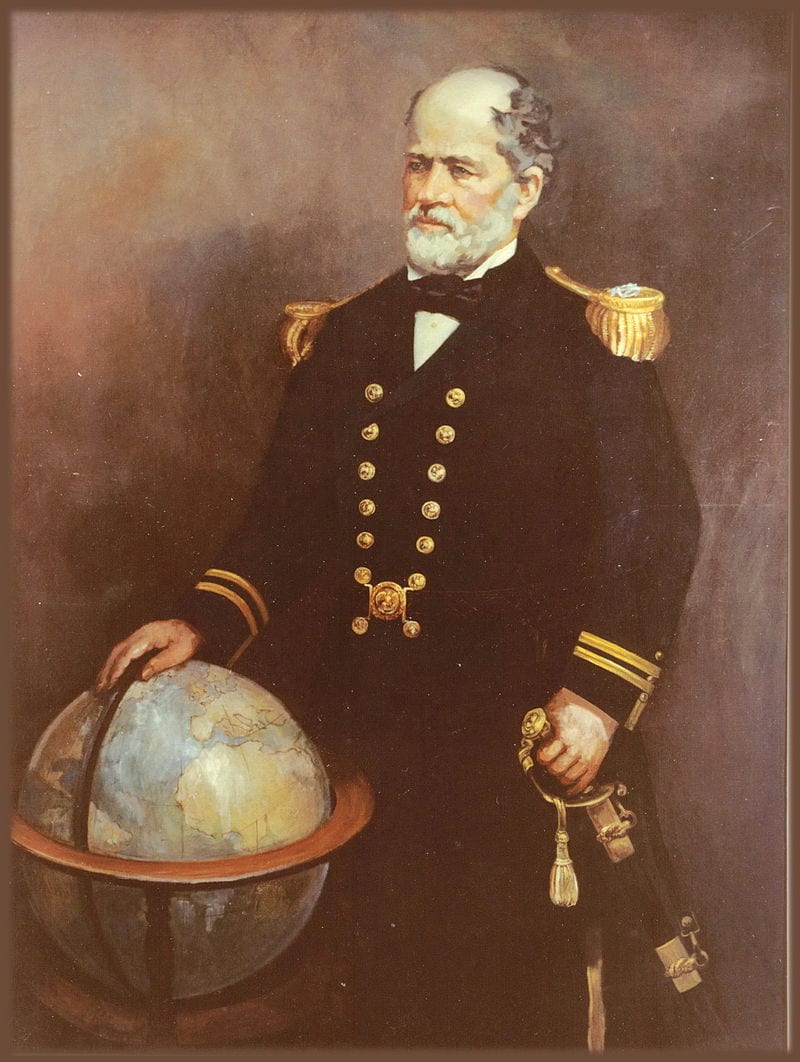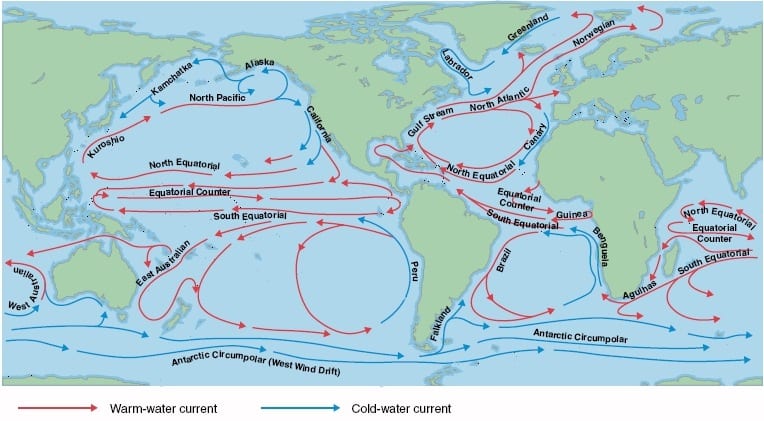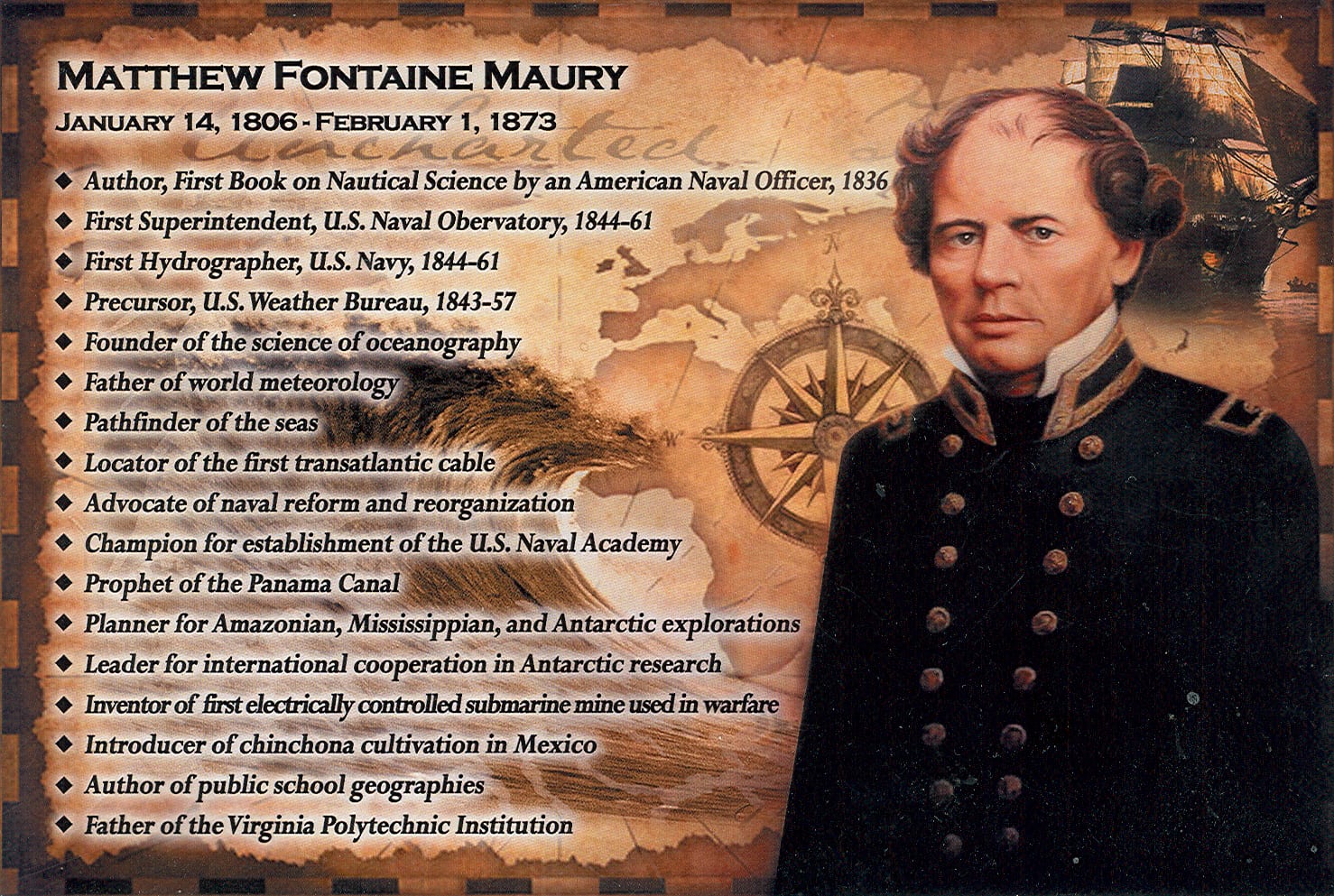 Matthew Fontaine Maury (The image right was painted by Ella Sophonisba Hergesheimer in 1923) was born in Spotsylvania County, Virginia in 1806 into a family whose lives were based around the Bible and the belief that it was the word of God. His ancestors were Huguenots who had fled France under the religious persecution of Charles IX. Throughout his life, he never disguised the fact that he could see God’s creation to be purposeful and there to be a clear relationship between science and creation.
Matthew Fontaine Maury (The image right was painted by Ella Sophonisba Hergesheimer in 1923) was born in Spotsylvania County, Virginia in 1806 into a family whose lives were based around the Bible and the belief that it was the word of God. His ancestors were Huguenots who had fled France under the religious persecution of Charles IX. Throughout his life, he never disguised the fact that he could see God’s creation to be purposeful and there to be a clear relationship between science and creation.
At the age of 19 he followed his brother into the United States Navy and sailed the oceans in the ships Brandywine and Vincennes. Later, he was appointed to the position of acting sailing master aboard the Falmouth. In this position, he was responsible for navigating the course, steerage and sail trim for the voyage.[1] During the passage around Cape Horn, he discovered that vital navigation information did not exist, so he kept meticulous records for his own use and the use of others. He later published them under the heading; The Navigation of Cape Horn in the journal, American Journal of Sciences and the Arts. Maury married Ann Herndon in 1834 and they settled in Fredericksburg, Virginia. In 1839, returning from visiting his parents, he was involved in a stagecoach accident and broke his femur which left him permanently lame and terminated his sailing career.
The following account is given in the booklet A Brief Sketch of the Work of Matthew Fontaine Maury, authored by Maury’s son, Richard Launcelot Maury[2]:
At one time, when Commodore Maury was very sick, he asked one of his daughters to get the Bible and read to him. She chose Psalm 8, the eighth verse of which speaks of “whatsoever walketh through the paths of the sea.” He repeated, “The paths of the sea, the paths of the sea. If God says the paths of the sea, they are there, and if I ever get out of this bed I will find them.”
When Maury recovered, he set out to discover the “paths of the sea.” As well, he was inspired by Ecclesiastic 1:6:
The wind blows to the south and goes around to the north; around and around goes the wind, and on its circuits the wind returns.
He concluded that in certain places, the wind might blow predominantly from one direction which would be a significant advantage for sailing ships if they knew it.
In 1841, Matthew Fontaine Maury became head of the US Navy’s Department of Charts and Instruments only to discover that the Navy had very few charts of the oceans! But it did have a big storeroom of logbooks from Navy ships. In these logbooks, sea captains travelling the North Atlantic had recorded their daily locations, as well, the speeds and directions of winds and currents. Maury realized the books contained a gold mine of information. By compiling records from many ships, he saw patterns. He made charts of ocean currents and winds that helped captains plot the best sea lanes for their voyages. Due to his initiative, a world-wide co-operative system to collect maritime information was organized. In 1852-53, he made a remarkable achievement in getting ten major maritime powers together for a meeting in Brussels. Even more remarkable was his ability to extract out of that gathering a unanimous agreement on the kinds of observations seamen should make and how they were to be recorded and processed for the benefit of all mankind. As a consequence, thousands of logs were sent into Maury’s observatory for the development and revision of wind and ocean currents.[3]
In addition to this collection of charts, Maury set adrift weighted bottles known as ‘drift bottles’. These floated slightly below the surface of the water so not to be affected by wind. Instructions were sealed in each bottle directing anyone who found one washed ashore to return it. From the date and location from which the bottles were found, Maury was able to develop charts of the ocean currents; the paths of the sea.
Matthew Maury combined all of this information to compiled extensive charts of wind circulations and sea currents, into a text book which he published in 1855 titled; The Physical Geography of the Sea and its Meteorology, the first textbook of modern oceanography. His work was invaluable to mariners and on some trips saving up to three weeks of sailing.
In his book, Maury gave glory to God for His creation and His holy book, the Bible; through which He gave Maury the key to unlock the mysteries of the oceans.
Maury claimed that his success in science was firmly based on his Christian commitment:
In observing the working and studying the offices of the various parts of the physical machinery which keeps the world in order, we should ever remember that it is made for its purpose, and that it was planned according to design and arranged so as to make the world as we behold it, a place for the habitation for man. Upon no other hypothesis can the student expect to gain profitable knowledge concerning the physics of the sea, earth or air.[4]
Maury’s legacy
He became a professor of meteorology at the Virginia Military Institute. He continued to write and in 1866 he published The World We Live In. In 1872, he became ill while conducting an exhaustive lecture tour. He died on February 1, 1873. Maury Hall was named in his honor at the Naval Academy in Annapolis. He also received honors from many parts of the world, including being knighted by several nations. Many monuments have been created to honor him, and he even has a crater named after him on the Moon. His important contributions to the fields of oceanography and ocean navigation have earned him many titles, including “Pathfinder of the Seas” and the “Father of Modern Oceanography” all because he believed that what the Bible says was true.
[1] Effie Munday, Creation, 6(2), 1983, pages 25-28.
[2] A brief sketch of the work of Matthew Fontaine Maury during the war, 1861-1865
by Maury, Richard L. (Richard Lancelot), 1840-1907, Richmond, Whittet and Shepperson, 1915. This quotation is found in the Introduction to the booklet which was written by Katherine C Stiles. https://archive.org/stream/briefsketchofwor00maur/briefsketchofwor00maur_djvu.txt.
[3] Effie Munday, Creation, 6(2), 1983, pages 25-28.
[4] M F Maury, Physical Geography of the Sea and its Meteorology, Edited by John Leighly, Dover Publications Inc, New York, 2003, page 114.


3 Comments. Leave new
Thank you
thanks for this very informative article
Prof. Maury’s discovery proves the Bible is true. Thank you